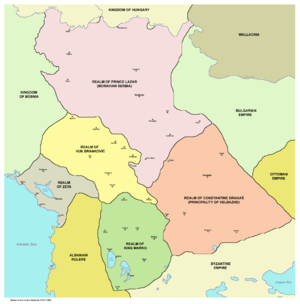Battle of Pločnik
Coordinates: 43°12′07″N 21°21′20″E / 43.20194°N 21.35556°E
| Battle of Pločnik | |||||||
|---|---|---|---|---|---|---|---|
| Part of the Ottoman wars in Europe | |||||||
 Central Balkans in 1373-1395. The battle was fought near Prokuplje. | |||||||
| |||||||
| Belligerents | |||||||
|
|
| ||||||
| Commanders and leaders | |||||||
| Lazar Hrebeljanović | Lala Şahin Pasha or Şahin Bey | ||||||
| Strength | |||||||
| c. 30,000 | c. 20,000 | ||||||
| Casualties and losses | |||||||
| few | c. 15,000 | ||||||
The Battle of Pločnik (Serbian: Битка код Плочника/Bitka kod Pločnika, Битка на Плочнику/Bitka na Pločniku) was fought sometime between 1385 and 1387[A] near the village of Pločnik (near Prokuplje in today's southeastern Serbia), between the Serbian forces of Prince Lazar Hrebeljanović and the invading Ottoman Army of Sultan Murad I.
Background
The Ottoman army penetrated Pomoravlje and neigbouring areas, killing and looting, then clashed with the subjects of Lazar at Dubravnica (1381), where they were successfully fought off.[1] With a larger force, the Ottoman Sultan Murad I attacked Serbia in 1386, when according to some sources Niš was conquered.[2]
Murad I had campaigned against the Karamanids and defeated their army near Konya.[3] Serbian soldiers from some vassal Serbian lords had accompanied the Ottoman army.[3] Some of the soldiers (including some Serbian soldiers) were executed because of looting civilian property, disobeying the Sultan's order.[3] Many of the vassal Serbian lords now began to support Lazar against the Ottomans.[3] At that time, one lord in Shkodër wrote a letter to the Sultan and promised to recognise Ottoman sovereignty and aid the Ottoman army if Ottoman troops were to be sent to protect him.[3] Murad I thus ordered a akinji commander, Kula Şahin Bey, to prepare his troops (according to Kemal Namık, this was not Lala Şahin Paşa, as is commonly believed).[3]
Battle
The Serbian army emerged victorious, although details of the actual battle are vague. Şahin Bey entered Serbia with 20.000 akinjis at that time he learned that Serbian lords had prepared an army to attack his troops. He advanced to Pločnik near Prokuplje but could not detect the position of that army, and believed that there was none. At that time, many akinjis (about 18.000) lost their temper and began looting civilian properties in the surrounding villages by disobeying orders. Şahin Bey stayed alone with 2,000 soldiers.[3] On the other hand, the battlefield was observed by Serbian expeditionary forces.
Suddenly an allied army with 30,000 soldiers appeared, many of whom were cavalry. The Serbian army used heavy knight cavalry charge with horse archers on the flanks. The Serbs first attacked the Ottoman center (2,000 soldiers), although they were unprepared and tasted nasty shock to heavy Serbian knights, the outnumbered Ottoman center resisted for some time but later began to withdraw with Şahin Bey[3] who barely escaped with his life.
Then the Serbian army turned to the other 18,000 akinjis that were busy plundering; unprepared, ill-disciplined, surprised akinjis couldn't do anything without their general. Only 5,000 of them returned home alive.[3] More than 60% of the Ottoman army was destroyed. According to tradition Serbian knight and folk hero Miloš Obilić participated in this battle and distinguished himself,[4] and was wounded by an Ottoman arrow.
According to some, such as Croatian historian Vjekoslav Klaić, Lazar's army was aided by Bosnian troops.[5] One version of the battle has it that the battle was won thanks to the Bosnian troops and the trickery of a Kastrioti.[6]
Aftermath
The victory gave prestige to the Serbs and their rulers, and temporarily slowed the Ottoman conquest of the Balkans. It was the first serious defeat of the Ottomans in the Balkans.[3] It was this battle that made Murad consider the possibility of abandoning his Balkan campaign. The Ottoman army next campaigned in Bosnia, fighting Bosnian troops led by Vlatko Vuković and Radič Sanković at Bileća (1388), ending in a decisive Bosnian victory, then in Kosovo, fighting Serbian troops at the Kosovo field (1389), ending inconclusively. Murad had decided to make one more powerful thrust aimed at the heart of the now seemingly revitilised Serbian Empire — Kosovo. Both Lazar and Murad fell in that battle.
According to the Ottoman historian Neşri this battle was not even fought because Prince Lazar was afraid to fight Ottoman army after Murad captured Niš, so he accepted to pay tribute and give 1,000 soldiers to serve the sultan.[7][8]
See also
Annotations
References
- ↑ Kalić 1984, p. 31; Stojanović 1927, p. 214
- 1 2 Kalić 1984, p. 31.
- 1 2 3 4 5 6 7 8 9 10 11 Namık 1982, p. ?.
- ↑ Mirčetić, Dragoljub (1994). Vojna istorija Niša. 1–3. Prosveta. p. 102.
- ↑ Klaić, Vjekoslav; Macan, Trpimir (1981). Povijest Hrvata od najstarijih vremena do svršetka XIX stoljeća. Nakladni zavod MH. p. 288.
- ↑ Đerić 1989, p. 25.
- 1 2 Ćirković 1990, p. 64.
- ↑ Tomac, Petar (1968). Kosovska bitka. Vojnoizdavački zavod. p. 87.
- ↑ Šuica 2011, p. 234.
Sources
- Namık, Kemal (1982). Osmanlı tarihi: Anadolu Selçukluları ve Anadolu beylikleri hakkında bir mukaddime ile Osmanlı devleti'nin kuruluşundan İstanbul'un fethine kadarv̲̲. 2. İstanbul'un fethinden Kanunı̂ Sultan Süleyman'nın ölümüne kadar. Türk Tarih Kurumu. pp. 200, 219, 250. (Turkish)
- Đerić, Branislav (1989). Kosovska bitka: vojno-istorijska rasprava. Naučna knjiga. p. 25.
- Ćirković, Sima M. (1990). Kosovska bitka u istoriografiji. Zmaj. p. 64.
- Šuica, Marko (2011). "O mogućoj ulozi Vuka Brankovića u Kosovskoj bici". Споменица академика Симе Ћирковића. Istorijski institut: 234–. ISBN 978-86-7743-091-7.
- Šuica, Marko. "Pripovesti": 99–108.
- Kalić, Jovanka (1984). "Niš u srednjem veku". Историјски часопис. Istorijski institut. 31: 31–. GGKEY:5LA3DP5RFU7.
- Stojanović, Lj. (1927). Stari srpski rodoslovi i letopisi. pp. 113, 117, 121, 215, 287.
- Novaković, Stojan (1878). Niš u prošlosti.
- Dinić, Mihailo (1938). "Žan Froasar i boj na Pločniku". Прилози за књижевност, језик, историју и фолклор. Belgrade. XVIII (18) (3–4): 361–365.